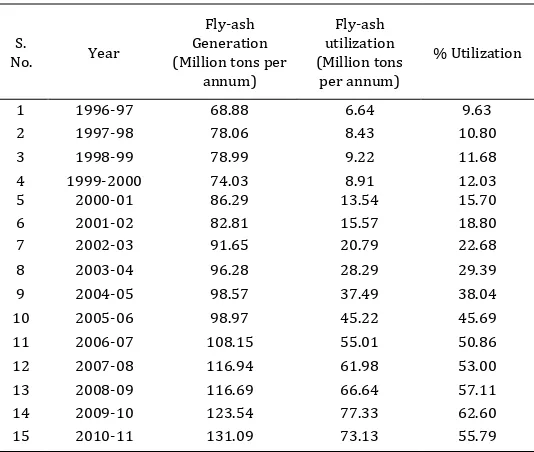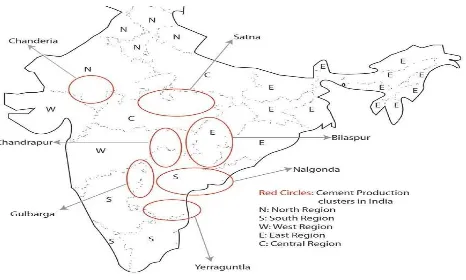Internat. J. Waste Resources, Vol. 3(1)2013:22-25, Md Emamul Haque ISSN : 2252-5211
22
© IJWR – ISSN: 2252-5211, 15th March 2013, All rights reserved
International Journal of Waste Resources (IJWR)
Journal homepage: http://www.ijwr.co
Indian fly-ash: production and consumption scenario
Md Emamul Haque
Department of Mechanical Engineering, Faculty of Engineering and Technology Jamia Millia Islamia (Central University), New Delhi 110025 INDIA
Email: [email protected]
Paper history:
Submission : February 21, 2013 Correction recieved: March 15, 2013
Accepted : March 22, 2013
doi:10.12777/ijwr.3.1.2013.22-25
Abstract— Electricity generation in India predominately depends upon coal based power plant for a couple of coming decades. Coal based power plant requires coal of high calorific value to generate optimum heat consequently to generate electricity, in this process a buy product which is also waste fly-ash or coal ash is produced. In India coal reserve is mainly is of lignite so the power plant burns this and produces ash, Indian coal average ash content is 35-38 percent. We require electricity, we burn coal and we produce fly-ash. In this research article the production of Indian fly-ash and consumption of it discussed.
Keywords — Fly-ash; Coal; Production; Consumption; Generation
[How to cite this article: Haque, M.E. (2013). Indian fly-ash: production and consumption scenario. International Journal of Waste Resources (IJWR), 3(1), 22-25]. doi:10.12777/ijwr.3.1.2013.22-25
I. INTRODUCTION
A fine, glass powder recovered from the gases of burning coal during the production of electricity is fly ash. These micron sized earth elements consist primarily of
silica, alumina and iron
(www.iflyash.com/whatisflyash.htm,2011). The combustion of powdered coal in thermal power plants produces fly ash. The high temperature of burning coal turns the clay minerals present in the coal powder into fused fine particles mainly comprising of aluminium silicate. Fly ash produced thus possesses both ceramic and pozolanic properties. When pulverized coal is burnt to generate heat, the residue contains 80 percent fly ash and 20 percent bottom ash. The ash is carried away by flue gas collected at economizer, air pre-heater and ESP hoppers. Clinker type ash collected in the water-impounded hopper below the boilers is called bottom ash (Parisaramahiti.kar.nic, 2007).
II. PHYSICO-CHEMICALANDMINEROLOGICAL PROPERTIESOFFLYASH
Flyash being a coal combustion residue shows a wide variation in their physic-chemical and mineralogical properties depending on the nature of parent coal, conditions of combustion, type of emission control devices,
storage and handling methods (Jala and Goyal, 2006). Flyash has a low bulk density, high surface area and light texture (Asokan et al, 2005) and (Jala and goyal, 2006), Flyash consists of mainly amorphous glass and a few crystalline phases.
III.COALDEMANDANDCOALASHGENERATION
Indian coal has high ash content. The average ash content in Indian coal is 35-38 per cent while imported coal ash content 10-15%. In this regard, washing will help reduce the ash content by 7-8 per cent (Source, the Indian Express, 2011).A large number of Coal/Lignite based thermal power plant 90 Nos. (Central Electricity Authority 2011-12) is setup for providing electric power to rapidly growing industrial as well as agriculture sectors. In which 70 percent of the electricity generated is from coal based thermal plants (India Energy book, 2012). In order to achieve the India economic growth of 8-9 percent, the country’s total coal demand, has been forecasted increase in ~ 730 Million tons in 2010-11 to ~2000 Million tons in 2031-32 of this approx. 75 percent of this coal would go thermal power plant (India Energy Book, 2012). The table below will present the projected coal demand
(Million tons).
Table 1. Projected coal demand (Million Tons) (Source India Energy Book, 2012
Sectors 2005-06 2006-07 2011-12 2016-17 2021-22 2026-27 2031-32
Electricity (A) 310 341 539 836 1040 1340 1659
Iron & Steel 43 43 69 104 112 120 150
Cement 20 25 32 50 95 125 140
Others 53 51 91 135 143 158 272
Non-Electrical (B) 116 119 192 289 350 403 562
Internat. J. Waste Resources, Vol. 3(1)2013:22-25, Md Emamul Haque ISSN : 2252-5211
23
© IJWR – ISSN: 2252-5211, 15th March 2013, All rights reserved In the above table demand of coal in the coming
decades so the generation of fly-ash will increase tremendously and the consumption rate is 54.33 percentages (Central Electricity Authority 2011-12) per annum, the consumption rate should be increased gradually to maintain a production-consumption balance. Further, the table given below shows the generation and utilization of fly-ash for the year 2010 and 2011 in India which aware us the contemporary consumption rate
Table 2. Generation and utilization of fly-ash in India 2010 and 2011 (Source: Central Electricity Authority annual Report 2010-11,
2011-12) Total Ash generated 131.09 Million
Tons
Percentage Utilization 55.79% 54.33%
IV. UTILIZATIONOFFLY-ASHSECTORWISEIN
Table 3 - Fly-ash utilization during the year (2010) (Source CEA annual report 2010-2011)
2. Reclamation of low lying area
Table 4 - Fly-ash utilization during the year (2011) (Sources: CEA annual report 2011-2012)
2. Reclamation of low lying area same with figure of 48.50 percent and 48.13 percentage in 2010 and 2011; in roads and embankment sectors has increase in percentage utilization from 11.65 percentages to 13.02 percentages. Otherwise other sector has decrease in percentage of utilization of fly-ash which decreases the overall percentage utilization in financial year 2011-12.
Table 5 - Fly-ash generation and utilization during the period 1996-97 to 2010-11 (Source: CEA annual report on fly-ash generation-utilization
2010-2011)
V. TRENDSOFFLY-ASHUTILIZATIONININDIA
Since 1996-97 to 2010-11 increase in fly-ash production is observed so the consumption (9.63 % in 1996-97 to 54.53 % in 2011-12, (Central Electricity Authority 2011-12)). India achieved utilization of 63 percentages, a highest level of fly-ash utilization in 2009-10 and 54.33 percentages in 2011-12.However, it would require lot of effort to achieve 95-100 percentage utilization. Concentrated efforts have been made by Department of Science and Technology, Government of India to increase the scale of utilization of fly-ash.
Internat. J. Waste Resources, Vol. 3(1)2013:22-25, Md Emamul Haque ISSN : 2252-5211
24
© IJWR – ISSN: 2252-5211, 15th March 2013, All rights reserved Table 4- Expected Fly-ash absorption in cement (million tons per annum)
(Source: WBCSD/CSI/LOW Carbon technology road map for Indian cement industry)
Serial No. Year
Expected Fly-ash absorption in Indian Cement Industry ( million tons per
annum)
1 2015 52.65
2 2020 73.01
3 2025 94.63
4 2030 120.50
5 2035 143.72
6 2040 158.02
7 2045 167.74
8 2050 177.45
"It is anticipated that the cement industry players will continue to increase their annual cement output in coming years and the country's cement production will grow at a compound annual growth rate (CAGR) of around 12 per cent during 2011-12 - 2013-14 to reach 303 MMT," (according to a report titled 'Indian Cement Industry Forecast to 2012', by research firm RNCOS).
Figure 1: Cement production and capacity utilization and India GDP data (Source: Central Statistics office and CMIE India)
Figure 2: The division of cement production & market on the map of India (Source: cementing growth, industry report, Ernst & Young, page 18-19)
VII. RESULTS AND DISCUSSION
In India, major source of power is generated through coal based thermal power plants resulting in huge quantity of flyash generation took place in past decade and hence its safe disposal is an important concern to safeguard the cleaner environment. In coming year
(2016-17) it is expected India will produce 300-400 Million Tons per year which is approximately double the quantity it is produced now so the consumption should be increased subsequently, the major use flyash is in the building material as a cement raw material and have many advantages like it reduces Green House gases emission, solve serious waste disposal problem faced by power generation industry, reduces energy requirement.
Recently a large utilization of flyash taking place in brick, industry setup took place in 2012-13 Jindal Steel Power Limited has started its plant in Angul, Raigarh and Patratu district in India producing fly-ash bricks of 1,80,000 bricks per day consuming fly-ash of 400 tons per day ( Angul Plant, JSPL 2012), 3,00,000 bricks per day consuming 550 tons per day ( Raigarh Plant, JSPL 2012 ), 50,000 bricks per day consuming 100 tons per day ( Patratu Plant, JSPL 2012 ).
Fly ash has a great application in the field of environment like treatment of waste water, construction activities tec. Utilization of fly ash in India has increased in various fields for example going from an open, dusty, dry transport of the flyash or by pumping of a water/flyash suspension to a special pumping system with low water content. The common flyash depot, dusty and dry, (with special care to avoid the blowing away) or a pond with an overflow of transport water now changes in a sticky, semi dry and consistent pond (for example: WEIR pumping system). Here are some areas which require further study on fly ash.
1. Considerations about the economic value of flyash. 2. Development and use of fine cement-less Ash-slag
concrete from secondary mineral resources. 3. Utilization of flyash in polymer industry.
Further increase in utilization of fly-ash in other sector (cement, roads and embankment, agriculture, mine filling, reclamation in low lying area) would definitely fulfil the more and more utilization scenario of Indian fly-ash
VIII.CONCLUSION
This paper has attempted to cover exorbitant amounts of information so that the reader can better understand flyash utilization Understanding coal combustion processes provides both a background and basis for the alternative uses of the resultant flyash. Flyash even though it is an environmental pollutant, it is an important raw material for various applications. The utilization of flyash in different sectors can help a great emphasis on the development of new technology for efficient utilization of flyash. Flyash utilization programme must be extensively taken up covering various aspects at different level to minimize the environmental pollution. There is a limited amount of research information on the environmental impact of flyash as an ingredient in the preparation of materials
REFERENCES
Internat. J. Waste Resources, Vol. 3(1)2013:22-25, Md Emamul Haque ISSN : 2252-5211
25
© IJWR – ISSN: 2252-5211, 15th March 2013, All rights reserved [2] Haque, Emamul M., “Indian coal: production and ways to increase
coal supplies” International Journal of scientific and research publication (IJSRP) Volume 3, Issue 2, February 2013.
[3] Kumar Vimal, Singh Gulab, Rai Rajendra,(2005) “FLY ASH: A MATERIAL FOR ANOTHER GREEN REVOLUTION”, Fly Ash Utilization Programme (FAUP) 2005 , TIFAC, DST, New Delhi. [4] Ashokan P,(1998), “Fly ash Vermicompost from non eco friendly
organic waste”, Pollution research 17(1), 5-11.
[5] Kumar B., Tike G.K. and Nanda P.K., 2007, ‘Evaluation of properties of high volume fly ash concrete for pavements’, Journal of Materials in Civil Engineering, Vol.19, No. 10, pp. 906-911. Doi: http://dx.doi.org/10.1061/(ASCE)0899-1561(2007)19:10(906) [6] Rao, B.K. and Kumar Vimal, 1996, ‘Fly ash in high strength
Concrete’, Recent Advances in Civil Engineering, National Seminar, September 28, pp.115-12.
[7] Diamond S., “The utilization of flyash”. 1984. Volume 14, Issue 4, 455-462.
[8] Arun Kumar .V, 2010, “Beneficial use of fly-ash – A review”, Indian School of Mines, Dhanbad.
[9] Asokan. P, 2005, “Coal combustion residues—environmental implications and recycling potentials, Resources, Conservation and Recycling” 43 (2005) 239–262.
[10] Fly ash utilization programme (FAUP), TIFAC, DST, and New Delhi 110016.
[11] Bhattacharjee U, Kandpal T C ,”Potential of flyash utilization in India, Energy” 2002, 27:151-66.
[12] Ahmaruzaman M.(2010), “ A review on the utilization of flyash progress in energy and combustion science”, Volume36(3), Pages 327-363.
[13] Naik T.R., S.S. Tyson, (2000), “Environmental benefits from the use of coal combustion products (CCP)”, C.V.J. Verma, S.V. Rao, V. Kumar, R. Krishnamoorthy (Eds), Proceddings of the second international Conference on Fly ash disposal utilization,pp4-43.
[14] Annual Report 2011, Ministry of Coal Government of India. [15] Annual Report 2010, Ministry of Coal Government of India. [16] India Energy Book 2012, (World Energy Council, Indian Chamber
Committee).
[17] Annual Report on Fly-ash utilization, Central Electricity Authority India 2010.
[18] Annual Report on Fly-ash utilization, Central Electricity Authority India 2011.


